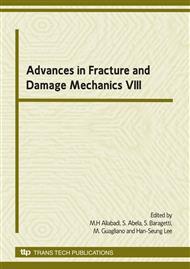p.105
p.109
p.113
p.117
p.121
p.125
p.129
p.133
p.137
Effect of Specimen Configuration and Loading Types on Fatigue Life of an Annealed 0.42% Carbon Steels
Abstract:
In the present study, a unified crack growth law based on the small fatigue crack growth law was investigated using specimens with different configurations and loading types for the annealed 0.42% carbon steel. Then, a convenient prediction method of fatigue life was proposed. This small fatigue crack growth rate was uniquely determined by the modified small crack growth law, , despite of changing for specimen configurations and loading types. The constants of can be estimated by an empirical equation of without stress/strain gradient. Considered the effect of stress gradient for different specimen configurations and loading types, the stresses under bending loadings and specimen configurations was calculated from that under push-pull loading. Therefore, the fatigue life of the specimens with different configuration and under different loading types can be simply estimated through the fatigue crack growth law based on the only tensile strength of carbon steels. The availability of proposed method was confirmed experimentally by the results of several carbon steels.
Info:
Periodical:
Pages:
121-124
Citation:
Online since:
October 2009
Authors:
Keywords:
Price:
Сopyright:
© 2010 Trans Tech Publications Ltd. All Rights Reserved
Share:
Citation:


